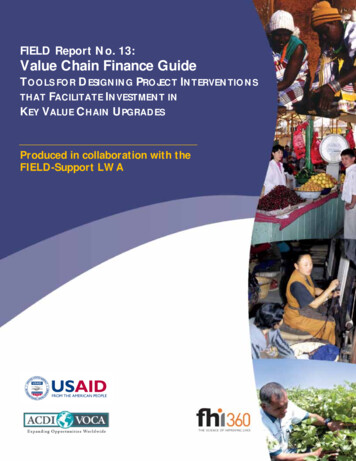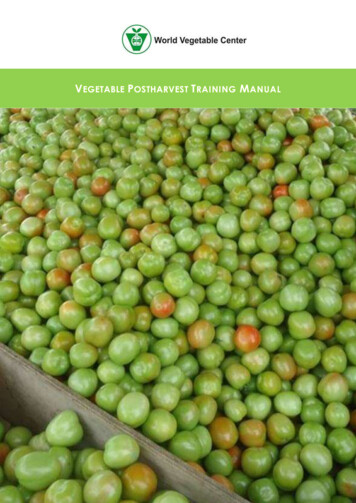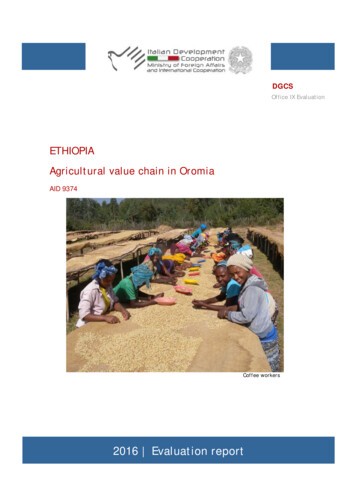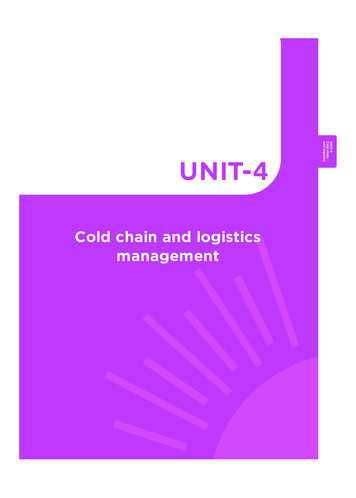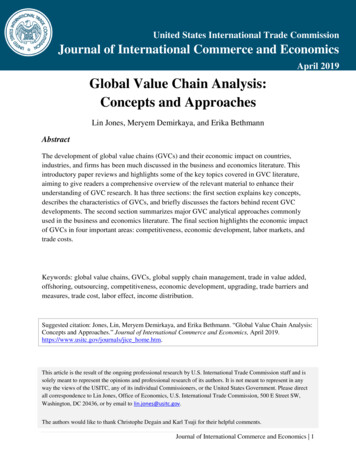
Transcription
Implemented by:VALUE CHAIN ANALYSIS FORTHE PHARMACEUTICALSECTOR IN JORDANIndustry Overview in JordanTrade for Employment (T4E) ProjectPublished in 2019In cooperation with:
Value Chain Analysis of the Pharmaceutical Sector in JordanList of Contents and TablesAbstract4Executive Summary5Macroeconomy6Table 1: Jordan’s Macroeconomic Indicators, 2014-2023 6Table 2: Jordan’s Foreign Investment Policy Enhancements (2017-2019)8Table 3: Jordan’s Top Contributing Sectors to GDP (2018)9Table 4: Jordan’s Export Distribution (2018)10Table 5: Jordan’s Largest Trade Partners (2018)10Global and Regional Trends in Pharmaceutical IndustryGlobal TrendsRegional Trends111112Industry Overview: Jordan13BackgroundProductionKey StakeholdersCompetitive LandscapeChart 1:Value and Volume Share of Generic vs. Originator Drugs, 2018Chart 2:Market Share by Value of Key Jordanian Companies, 2018Role of GovernmentLabour NeedsMarket Demand and Supply - Production and ConsumptionTable 6: Production Volume and Value 2015-2018Table 7: Consumption Volume and Value 2013-2018Market Demand and Supply - Imports and ExportsTable 8: Jordan, Declared Imports Trade ValueTable 9: Jordan, Declared Imports Trade Value (USD Million), Including Main MarketsTable 10: Jordan, Declared Exports Trade Value (USD Million), Including Main MarketsTable 11: HS Codes for ue Chain Analysis24Research and Development (R&D)SourcingRegistrationProductionTable 12: Share of Costs in the Production of Pharmaceuticals in Jordan in 2018Packaging and StorageDistribution and Marketing: Local MarketExports2424252626272727 Euromonitor International Ltd 2019. Applicable terms and conditions of use and the disclaimer at the front of this document apply.
Value Chain Analysis of the Pharmaceutical Sector in JordanExport ProcessOverviewExport Procedures and Supply Chain282829SWOT Analysis30Potential New Export Markets34Export Profiles - BelarusChart 3:Marketing Mix of Pharmaceutical Products in BelarusExport Profiles - RussiaChart 4:Marketing Mix of Pharmaceutical Products in RussiaExport Profiles - UkraineChart 5:Marketing Mix of Pharmaceutical Products in Ukraine353536373838International Case Study: Bulgaria40BackgroundMacroeconomyTable 17: Bulgaria, Macro-Economic Indicators 2014-2023Market Demand and SupplyTable 18: Bulgaria, Declared Imports Trade Value (USD Million), Including Main MarketsValue Chain Analysis - Research and Development (R&D)Value Chain Analysis - SourcingValue Chain Analysis - RegistrationValue Chain Analysis - ProductionTable 19: Key Conversion Costs in Bulgaria’s Pharmaceutical Industry, 2018Value Chain Analysis - Packaging and StorageValue Chain Analysis - Distribution and MarketingValue Chain Analysis - ExportsTable 20: Bulgaria, Declared Exports Trade Value (USD Million), Including Main MarketsChallengesRecommended ExperiencesTable 21: Export Strategy Development Program, Bulgaria, 2012Table 22: Similarities and Differences between Jordanian and Bulgarian Pharmaceutical mmendations: Opportunities for Growth and Development49Strengths and WeaknessesTable 13: Strengths of Local Players in the Pharmaceutical SectorTable 14: Weaknesses of Local Players in the Pharmaceutical SectorOpportunities and ThreatsTable 15: Opportunities in the Pharmaceutical SectorTable 16: Threats to the Pharmaceutical SectorOverviewStrategic Directions Road MapOther Recommendations Euromonitor International Ltd 2019. Applicable terms and conditions of use and the disclaimer at the front of this document apply.303031323233494954
4Value Chain Analysis of the Pharmaceutical Sector in JordanAbstractThe Deutsche Gesellschaft für Internationale Zusammenarbeit GmbH (‘GIZ’) is looking to invest in Jordanin key sectors in order to increase job creation as part oftheir focus on Employment and Education. GIZ hencecommissioned Euromonitor to assess the pharmaceuticaland chemical sectors in Jordan to identify and understandwhat needs to change in order to increase exports andmake Jordanian products more competitive. This is part ofthe Trade for Employment (T4E) project that focuses onbuilding capacities and strengthening structures in a sustainable manner to enhance the conditions of Jordaniancompanies to increase their trade performance for employment. GIZ need to know what fields of intervention theT4E team can focus on over the course of the coming 3years to help Jordanian companies increase export.The present study provides an in-depth analysis of thecurrent pharmaceutical industry in Jordan and its outlook. The focus of the study is to reach a comprehensiveassessment of Jordan’s regulatory framework, possibleinnovation-facilitating instruments, and key innovationassets – research and human capital. It proposes a strongermonitoring and evaluation (M&E) framework and provides a sectoral analysis with respective recommendationsin key areas.The methodology used in order to reach this objectiveconsisted of a combination of extensive primary andsecondary research to gather data that was subsequentlycleaned, processed and analysed in order to obtain insightson the situation of the value chain and on potential stepsfor improvement. Data gathered from secondary sourceshas been blended with in-depth interviews with stakeholders of the industry such as manufacturers, exporters andindustry specialists. These results were complemented withknowledge on international best practices and research oncase studies of other developing countries (e.g. Bulgaria),which has been successful in developing their pharmaceutical industry. The international benchmarking studieshave emphasised on the importance of increasing the efficiency in the production processes, start substantial R&Dpractices, combat cost pressures and explore new exportopportunities. Euromonitor International Ltd 2019. Applicable terms and conditions of use and the disclaimer at the front of this document apply.
5Value Chain Analysis of the Pharmaceutical Sector in JordanExecutive SummaryThis report presents a review of current issues in the pharmaceutical sector in Jordan. It examines the government’srole (drug policy, regulations, pricing), the value chain(sourcing, R&D, production, packaging, storage, distribution) and the export process (which represents estimated 70% of profit generation)1. Its recommendationsare intended to serve as practical options for reform, byarticulating short- and medium-term low-cost strategiesfor managing pharmaceutical expenditure and increasingbusiness opportunities in both local and foreign markets.Other issues include JFDA unified pricing regulations, bywhich the vast majority of generics are set on a fixed pricefor local sale, with this price also acting as a benchmarkfor export negotiations with foreign importers. This reportaddresses the need for a registration process that streamlinesmanufacturers’ local/foreign drug sales, in order to securea healthy cash flow. Moreover, it is imperative that localmanufacturers (supported, if possible, by foreign cooperation agencies) invest in the development of more lucrativedrug alternatives, such as super-generics and biosimilars.Jordan is considered a pioneer among countries in theArab world in terms of the pharmaceutical industry, beingrecognised as a cost-efficient manufacturer of high-qualitygeneric drugs, with the industry being worth estimatedUSD 1.2 billion in 20182. Despite this positive positioning, the country’s industry has not managed to evolveinto a manufacturing originator stage (developing originalmolecules for medicines), due to the limited allocationof resources for R&D by both private and public sectors.Moreover, the country faces a significant dependenceon foreign active pharmaceutical ingredients (APIs) forthe sourcing stage, and is increasingly focusing on highlylucrative re-export activity, which trades pharmaceuticalproducts from Western nations (Germany, USA, France,Switzerland) into neighbouring Arab countries. Private andpublic stakeholders must recognise these market trends/threats and implement moderate reforms in order to securecompetitiveness, profitability and higher levels of employment for the sector (currently estimated at 26,000 workers).Other significant actions required are a higher investmentin local workforce capabilities, as the vast majority of theindustry relies on poorly-qualified blue-collar workers,which are trained in-house to reduce human resourcecosts. Local manufacturers must understand that thepharmaceutical industry cannot evolve if they insist onconservative low-cost production models, based on theemployment of uneducated staff that earns salaries as lowas USD352 a month.Local manufacturers indicate that their operations couldbenefit greatly from extended support of the Jordan Foodand Drug Administration (JFDA)3 during the drug registration process . Sources state their operations are greatlyaffected by slow registration periods for new drugs,intended for both local and export markets.In conclusion, both private and public stakeholders haveto recognise the need for modernisation of the pharmaceutical industry in order to open up further business opportunities. Export trends benefitted from growth in MiddleEastern economies (mainly GCC countries) in recentyears, which resulted in increased government spending onthe healthcare sector and the implementation of mandatory health insurance schemes. Jordanian manufacturers/exporters must focus on capitalising on these trends, asincreasing life expectancy and literacy rates regionally areexpected to lead to a greater awareness of health-relatedissues and a consequent increase in demand for high-quality, cost-efficient pharmaceutical products.1 Euromonitor International trade analysis, 20192 Euromonitor International trade analysis, 20193 Euromonitor International trade analysis, 2019 Euromonitor International Ltd 2019. Applicable terms and conditions of use and the disclaimer at the front of this document apply.
6Value Chain Analysis of the Pharmaceutical Sector in JordanMacroeconomyJordan has one of the smallest economies in the MiddleEast (USD42.3 billion in 2018), and its lack of naturalresources and water scarcity put constrains on economicdevelopment. Following the global financial crisis of 2008growth slowed significantly; the deteriorating regionalsituation since 2011 and subsequent mass influx of Syrian refugees has made recovery difficult, though marginalincreases in growth are predicted in the coming years. In2015, the government launched “Jordan 2025”, a nationalvision for economic and social development which analyses the challenges faced by the country and reviews thegoals and aspirations to be achieved by 2025. Through thismodel, the economy is expected to increase between 4.8%to 7.5% in a 10-year period4.Annual GDP growth dropped from 8.2% in 2007 (priorto the global financial crisis) to 2.0% in 20175. Jordan’strade deficit reached USD11.4 billion in 20186 – largelydue to its reliance on energy and food imports – the country reported a fiscal deficit of USD459.9 million in 20177.The debt to GDP ratio rose to 95.9% in 2017, reachingUSD38.4 billion8. While foreign currency reserves arehigh, and inflation is stable, the informal sector is significant, accounting for an estimated 17% of GDP in2017. The economy is expected to improve in 2019. There-opening of the border with Iraq and associated tradeand investment agreements; the extension and broadeningof the trade agreement with the European Union; as wellas other efforts to lower the cost of generating energy, allbode well for a steady recovery in investment, exports,competitiveness, and economic growth. Real GDP growthis expected to average about 2.5% in 2020, before climbing to around 3.0% per year over 2022-20269. Jordan’sunemployment rate reached 18.6% in 2018 , an unprecedented level unseen in the last 25 years.Table 01: Jordan’s macroeconomic indicators, 2014-2023Source: Euromonitor International4 int5 https://data.worldbank.org/country/jordan6 http://dosweb.dos.gov.jo/7 drops-958-gdp-budget-deficit-rises-jd4351-million8 drops-958-gdp-budget-deficit-rises-jd4351-million9 Euromonitor International10 http://dosweb.dos.gov.jo/ Euromonitor International Ltd 2019. Applicable terms and conditions of use and the disclaimer at the front of this document apply.
7Value Chain Analysis of the Pharmaceutical Sector in JordanEconomic StrengthsStrategic LocationJordan is well situated as a regional entry point, being wellconnected to neighbouring countries and global marketsthrough modern transportation and communicationnetworks. Jordan’s location allows for diversification andexpansion into increasingly affluent markets. Trade agreements give Jordan access to a market of more than onebillion consumers.Stable MacroeconomyJordan’s macro-economic fundamentals are sound andleading indicators point to continuing slow growth anddevelopment over the next several years. Careful planningand policy reforms, a strong economy, and the creation ofideal conditions ripe for business investment have led to asurge in foreign investment in Jordan.Favourable Business Policy FrameworkJordan is a free market-oriented economy (an economicsystem in which prices are determined by unrestrictedcompetition between privately owned businesses), withoutward-oriented economic policies and a private sector-led approach to business development. Jordan experienced ongoing privatisation in recent years of major stateowned enterprises and implemented significant advancesin structural and legal reform.Qualified and Talented WorkforceJordan’s human capital includes training investments in thehigh-tech, manufacturing and service sectors, while labourcosts remain the most competitive in the Middle East.Foreign RelationsDecades of political stability and security ranked Jordan asone of the top 10 countries in terms of security worldwidein 201711. Jordan has good relations with all its neighboursand has maintained continuous stability, moderation andsecurity in a region prone to potential volatility. Jordan isan active member of the UN and several of its specialisedagencies, including the Food and Agriculture Organisation(FAO), International Atomic Energy Agency (IAEA), andWorld Health Organisation (WHO). Jordan is a memberof the World Bank, International Monetary Fund (IMF),Organisation of Islamic Cooperation (OIC), Non-AlignedMovement and Arab League.11 afest-country-worldwide-2nd-among-arab-states12 conomy/jordan Euromonitor International Ltd 2019. Applicable terms and conditions of use and the disclaimer at the front of this document apply.
8Value Chain Analysis of the Pharmaceutical Sector in JordanTable 02: Jordan’s Foreign Investment Policy Enhancements (2017-2019)Source: Euromonitor International from The World Bank Euromonitor International Ltd 2019. Applicable terms and conditions of use and the disclaimer at the front of this document apply.
9Value Chain Analysis of the Pharmaceutical Sector in JordanContribution to EconomyJordan’s top contributing sectors to GDP are governmentservices, finance, manufacturing, tourism & hospitality,transport and construction respectively13.Table 03: Jordan’s top contributing sectors to GDP (2018)Source: Central Bank of Jordan13 sh.pdf?lang ar14 20in%20jordan.pdf Euromonitor International Ltd 2019. Applicable terms and conditions of use and the disclaimer at the front of this document apply.
10Value Chain Analysis of the Pharmaceutical Sector in JordanExportsJordan’s top 10 exports accounted for over two-thirds(68.8%) of the overall value of its global shipments.Inorganic chemicals were the fastest-growing among thetop 10 export categories, up by 21% from 2016 to 2017.Table 04: Jordan’s export distribution (2018)Trade PartnersSource: Central Bank of JordanNeighbouring countries in Africa and Middle Eastaccounted for almost half of Jordan’s exports and almosta third of all imports sources in 2018, making them thecountry’s largest trade partners.Table 05: Jordan’s largest trade partners (2018)Source: Euromonitor International Euromonitor International Ltd 2019. Applicable terms and conditions of use and the disclaimer at the front of this document apply.
11Value Chain Analysis of the Pharmaceutical Sector in JordanGlobal and Regional Trends in Pharmaceutical IndustryGlobal TrendsThe global pharmaceutical sector is experiencing cuttingpricing pressure from multiple governments, which areinterested in curbing healthcare costs by setting pricingregulations. This affects overall profit margins for pharmaceutical operations15. Operational/development trends in2018-2019 are focused on overcoming this profitabilityissue, either by exploring more lucrative business opportunities (such as biosimilars) or by implementing cost-efficient measures to reduce overall costs. The most significanttrends can be summarised below.Industry 4.0 in manufacturingIndustry leaders recognise the sector must become morestreamlined and cost efficient at manufacturing its products. Adoption of disruptive Industry 4.0 technologiesoffers a potential solution, such as setting up intelligentfactories with highly integrated, flexible IT and manufacturing systems. This type of investment allows companiesto increase productivity, by implementing a higher levelof automation and control on human intervention, whilescaling-up production through data driven program management16.Biosimilars to gain further groundProduction of biosimilars (medicines that are made fromliving microorganisms found in plant or animal cells) isexpected to be spurred by the loss of patent protection forbestselling biologics. Industry reports indicate 66 innovator biologics are due to come off-patent in the marketbetween 2020 and 2025. Consequently, it is expectedthere will be an increasing number of biosimilar reviewapplications to FDAs in the incoming years. This is especially attractive to the pharmaceutical sector, as the sectoroffers more lucrative opportunities, as this type of productis mostly destined to premium, high-value-added drugs17.Pharmaceutical companies to restructure in search ofcost efficiencyPharmaceutical companies are continuing to reduce overallcosts, by reducing staff, refocusing R&D, closing manufacturing plants and divesting poorly-performing or sub-scalebusinesses. These savings are expected to be used to re-stockpipelines with promising new drug candidates18.Artificial Intelligence (AI) to be implemented in R&DAI will increase drug development efficiency by streamlining research efforts. The predictive and analytical powersof AI are expected to enable companies to make smarter,faster, and more strategic decisions, by collecting andaggregating disparate data sets and identifying patterns,which in turn will generate more insights19.Mergers and Acquisitions (M&A) expected in 2019M&A will be driven by a need to consolidate a highly fragmented business sector. Large pharmaceutical companiescontinue to outsource more of their manufacturing activityand want to simplify the outsourced manufacturing supply chain by having larger integrated suppliers. Investors,fuelled by the continued availability of relatively low-costfinance, will see this as an opportunity to be the consolidator in an evolving, long-term successful business sector20.ConclusionA combination of these strategies is used to overcome adeteriorating trade environment in the light of pendingBrexit and the US-China trade disputes, as well as thementioned regulatory pricing measures from governments.Company revenues, especially in North America, are alsoexpected to be negatively affected by pending patent expirations for some high-revenue drugs.15 Euromonitor International16 dustry-40-applied-pharmaceutical-manufacturing/17 ilars-market-boom-ahead-bpcia-10th-anniversary/18 /pharma-outlook-12-trends-watch-2019/19 -and-biomedicine/20 gets-to-watch-in-2019/ Euromonitor International Ltd 2019. Applicable terms and conditions of use and the disclaimer at the front of this document apply.
12Value Chain Analysis of the Pharmaceutical Sector in JordanRegional TrendsThe MENA pharmaceutical industry currently benefitsfrom multiple demographic factors, such as changing population dynamics, where population is increasing but alsoageing rapidly. The population of the region is increasingat 2% per year (7 million per year), the second highest ratein the world after sub-Saharan Africa. The MENA’s population is expected to nearly double in the next 50 years21.Life expectancy of the average MENA inhabitant is now73 years of age, close to that of many developed nations22.Additionally, lifestyle changes have led to higher incidencesof non-contagious chronic diseases and conditions such ascardiovascular disease, obesity and type-2 diabetes23.The current landscape of the pharmaceutical markets inthe MENA region varies greatly between different nations.A high spending power and a cultural preference forexpensive foreign brands in Saudi Arabia has resulted in85% of pharmaceuticals in the country being imported24,whereas in Egypt, 90% of consumption is locally producedwith a much greater market share for generics25. Jordan iscurrently the only country in the Middle East with a positive pharmaceutical manufacturing trade balance, as it hasa well-established industry and many years of experience,exporting reported 70% of its pharmaceutical produce,with a generic penetration of over 50% in its market26.In general, MENA governments and private sectors areinterested in increasing their pharmaceutical manufactur-ing installed capacity. Morocco for example has becomean emerging player in the global pharmaceutical market,thanks to its stable political framework and key geographicposition in the Mediterranean area. Both domestic andmultinational pharmaceutical companies are present inthe country with manufacturing facilities27. In 2015, theindustry in Morocco was able to cater for 65% of theirlocal demand (compared to 49% in Tunisia and 30% inAlgeria)28. Saudi Arabia is actively trying to increase genericconsumption through regulating imported branded drugsand promoting local generic production, by presentingopportunities for local generics manufacturers and for foreign firms who are willing to move into the country. Sanofiopened a new production facility in King Abdullah Economic City in Saudi Arabia in December 2014, producingantibiotic drugs, diabetic treatments and cardiovasculardrugs29. Countries such as Algeria and Sudan are enforcingprotective trade mechanisms to ensure priority to locallyproduced drugs by banning imports of those drugs fromother countries.Further growth of the pharmaceutical market in theMENA region is likely to manifest in the forms of moreindividuals getting private health insurance, the development of medical tourism, increases in local manufacturing,better access to innovative drugs and the possible drugprice harmonization strategy among GCC countries aspart of a potential pharmaceutical free trade agreement30.21 nthemiddleeastandnorthafrica/22 https://ubmemeaensoprod.s3.amazonaws.com/CPHI mea/cphi pharma insights mea - final.pdf23 rma-market-an-untapped-opportunity-000124 https://books.google.com.ni/books?isbn 191006807125 iddle-east-north-africa-pharmaceutical-market-in26 http://citeseerx.ist.psu.edu/viewdoc/download?doi 10.1.1.1031.2223&rep rep1&type pdf27 8 y-business/mena-pharmaceutical-market29 0 asted-for-mena-pharma-market/ Euromonitor International Ltd 2019. Applicable terms and conditions of use and the disclaimer at the front of this document apply.
13Value Chain Analysis of the Pharmaceutical Sector in JordanIndustry Overview: JordanBackgroundThe Jordanian pharmaceutical sector is an advanced sectorin the region. The country’s first pharmaceutical company,Arab Pharmaceutical Manufacturing Company (APM),was established in 1962. During the 1990s, the sectorwitnessed remarkable development with the establishmentof nine companies. This development was a direct resultof the flow of capital from Gulf states, such as Iraq, dueto the Gulf War and because the Jordanian governmentenacted several laws and procedures regarding investmentto encourage and facilitate investment in Jordan . Furthermore, the healthcare system in Jordan has a strongreputation across the region given its international qualitystandards, local experts and world-class hospitals31.By 2018, the pharmaceutical sector comprised 23 companies, registered at the Jordanian Association of Pharmaceutical Manufacturers (JAPM), which manufacture mostlybranded generics (formulated drugs that have lost patentprotection). Both public and private healthcare systems aresupplied by these manufacturers. Physicians, hospitals andpharmacies generally buy pharmaceuticals directly fromthe manufacturer or through a distributor. Prices are fixedby the Jordanian Food and Drug Administration (JFDA)and hence companies compete on brand building. Thefirst company to introduce a generic version of a drug willmost likely gain the largest market share. Manufacturersdevote around 5% of their installed capacity to contractmanufacturing for global pharmaceutical companies32.The industry caters to two main markets: Prescriptionand Over-the-Counter (OTC) medication. It is estimatedthat 70% of pharmaceutical drugs produced in Jordan areprescribed, while 30% are over-the-counter (OTC) drugs.Local pharmaceutical companies are primarily engaged inproducing several dosage forms such as solids, semi-solids, liquids and injectable. Specialties include antibiotics,anti-ulcer cures, hormones and anti-cancer treatments.Jordanian pharmaceutical firms such as MS Pharma arealso venturing into bio-technology via partnerships andrather not directly into actual manufacturing in Jordan.The Jordanian pharmaceutical industry grew in terms ofinvestment volume, having invested around USD263.7million over 2005-2015 in their manufacturing infrastructure, including their laboratory facilities. In 2017, pharmaceuticals ranked second in Jordanian exports despitethe fact that 40% of its production depends on concessionrights to foreign companies and 60% depends on licenses.These factors tend to affect medium-term planning as concessions and licenses can be revoked. At the same time, theindustry’s products accounted for nearly 8.9% of total Jordanian exports in 2017, with the products being exportedto more than 60 countries due to their high quality, excellent reputation and competitive pricing33.The industry contributed to the development of the Jordanian economy as it provided jobs to 26,000 people andhard currency from exporting over 75% of its production34. It is reported that females make up 40% of thesector’s workforce.The sector is one step ahead of its regional counterpartsas it imposed a law on performing bio-equivalency studiesthrough Contract Research Organisations (CRO) in 1999,with seven CROs currently in Jordan. CROs in Jordanprovide clinical and bioanalytical services for the pharmaceutical industry.ProductionIndustry sources report that local production of pharmaceuticals was estimated at USD1.2 billion in 201735.Given the small size of the local market, exports representnearly 75% of local production.36The sector reports an average value Compound AnnualGrowth Rate (CAGR) of 4.5% over 2013-2018, supported by consistent foreign demand from Saudi Arabia,Algeria and Iraq. However, in recent years, demand fromthese countries downsized as governments in these marketsare limiting imports to strengthen their local industries.Demographic trends in the region, such as increasinglife expectancy and literacy rates, are expected to lead toa greater awareness of health-related issues and a consequent increase in demand for pharmaceutical products.Global innovation has become more complex and despitecontinuing R&D spend, new drug approvals are lagging.Jordanian pharmaceutical companies are expected tocontinue focusing on generic manufacturing and as such,industry sources expect a similar performance over 20192023, with value CAGR of 4-6%37.31 0.pdf32 Euromonitor International trade analysis, 201933 www.JAPM.com34 Taifour, M., 2011. The relationship between the capital expenditure and financial operational performance in Jordanian pharmaceuticalmanufacturing corporations. MSc Thesis, Middle East University, Amman, Jordan.35 Euromonitor International trade analysis, 201936 Euromonitor International trade analysis, 201937 Euromonitor International trade analysis, 2019 Euromonitor International Ltd 2019. Applicable terms and conditions of use and the disclaimer at the front of this document apply.
Value Chain Analysis of the Pha
Chart 1:Value and Volume Share of Generic vs. Originator Drugs, 2018 15 Chart 2:Market Share by Value of Key Jordanian Companies, 2018 17 Role of Government 18 Labour Needs 19 Market Demand and Supply - Production and Consumption 20 Table 6: Production Volume and Value 2015-2018 20 Table 7: Consumption Volume and Value 2013-2018 20


